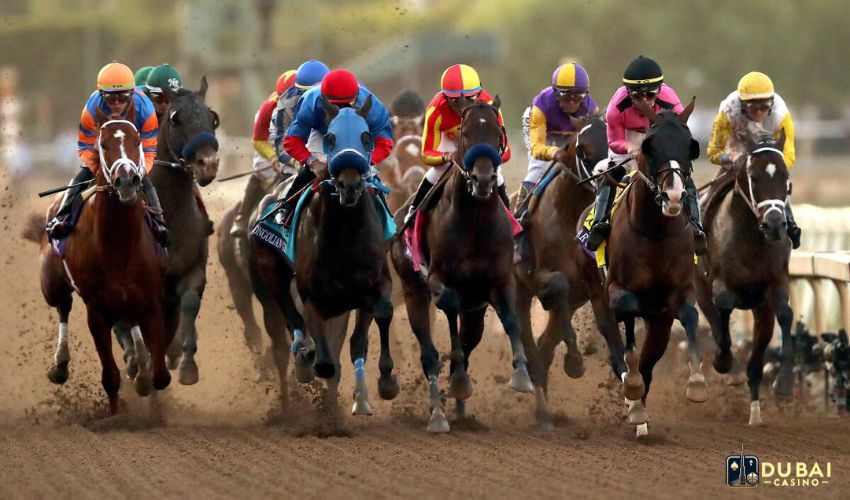Show Bets in Horse Racing
Show betting represents one of the most straightforward wagering options available at the racetrack.
When you place a show bet, you are not betting on your horse to win outright; you are betting it will finish somewhere in the top three positions.
Many newcomers to horse racing start with show bets because they provide a higher probability of winning compared to other bet types.
The beauty of a show bet lies in its simplicity. You select one horse, and as long as that horse crosses the finish line in first, second, or third place, you collect money.
Unlike more complex exotic wagers that require predicting exact finishing orders of multiple horses, show bets only require your selection to be among the top three finishers.
How Show Bets Work?
Placing a show bet follows a simple process. First, you select the horse you believe will finish in the top three positions in a particular race.
At the betting window or online platform, you specify the amount you wish to wager, the race number, and indicate it is a show bet.
For example, you might say: “$2 show on horse number 5 in race 3.”
The minimum stake for show bets typically starts at $2 at most tracks, though some venues have experimented with $1 or even $0.50 minimums.
Show bets operate within the parimutuel betting system, where all show bets are pooled together.
After the track takes its commission (known as the takeout), the remaining money gets distributed among those who bet on horses that finished in the top three positions.
If your horse finishes “off the board” (fourth place or worse), you lose your entire stake.
However, you win the same amount regardless of whether your horse finishes first, second, or third.
The payout remains consistent as long as your horse appears somewhere in the top three.
Show Bet Payouts
Show bet payouts generally offer the lowest returns among straight wagers but compensate with higher winning probabilities.
The takeout for show bets typically averages around 18%, though this varies by track and local regulations.
Payouts are calculated by dividing the remaining pool (after the takeout) among all winning tickets.
Since three horses qualify for show positions in each race, the payout pool gets split three ways.
Each winning horse’s payout is determined by how much money was wagered on that horse to show-horses with more money bet on them pay less than longshots.
For example, if a heavily favored horse finishes in the top three, those who bet on it might receive a small payout like $3.20 on a $2 bet.
Meanwhile, a longshot finishing third might pay $16.80 on the same $2 wager because fewer people bet on that horse.
Best Horse Racing Betting Platforms
The best horse racing betting platforms for Dubai bettors are:
Advantages and Disadvantages of Show Betting
Show betting offers distinct benefits for certain types of bettors.
The primary advantage is the increased winning probability. By needing your selection to finish only in the top three rather than win outright, your chances of collecting a payout improve significantly.
This makes show bets excellent for beginners, cautious bettors, or those looking to maintain bankroll stability through consistent small wins.
The main drawback relates directly to the reduced risk-lower potential returns. Show bet payouts rarely generate substantial profits, particularly on favorites.
A heavily backed favorite might return just pennies on the dollar, sometimes paying as little as $2.10 or $2.20 on a $2 bet-essentially returning your stake with minimal profit.
When to Use Show Bets?
Show bets prove most valuable in specific racing scenarios. Consider using them when:
- You are new to horse racing and learning how wagering works
- You have identified a consistent horse that regularly finishes in the top three but does not always win
- You want to cautiously bet on a longshot that shows potential without the risk of a win-only bet
- You are dealing with a competitive field where picking the outright winner seems challenging
- You are using show bets as part of a broader betting strategy to manage risk
Show betting becomes particularly useful when you identify horses with solid fundamentals that might lack the final burst needed to win but consistently secure in-the-money finishes.
Show Bets vs. Other Straight Wagers
Horse racing offers three primary straight wagers: win, place, and show. Each requires a different finishing position for success.
Win bets pay only if your horse finishes first, place bets pay if your horse finishes first or second, and show bets pay if your horse finishes in the top three.
This progression follows a clear risk-reward relationship. Win bets offer the highest potential payout but the lowest probability of success.
Place bets provide moderate risk and reward. Show bets deliver the highest winning probability but the lowest returns.
For example, in a recent Kentucky Derby, a $2 show bet on the first-place finisher paid $5.00, while the third-place finisher’s show bet paid $16.80.
These payouts illustrate how favorites typically offer smaller show returns, while longshots can still provide decent value even on show bets.
Across the Board Betting
The “across the board” bet combines all three straight wagers (win, place, and show) on a single horse.
This combination bet requires three times your base stake-a $2 across-the-board bet actually costs $6 because you’re placing a $2 win bet, a $2 place bet, and a $2 show bet simultaneously.
If your horse wins, you collect on all three bets. If it finishes second, you collect on the place and show portions.
If it finishes third, you only collect on the show portion. This betting approach provides coverage across multiple finishing positions but requires a larger investment.
Across-the-board betting works well when you have moderate confidence in a horse with decent odds.
The win portion captures significant value if successful, while the place and show components provide safety nets if your horse runs well but does not win.
Tips for Successful Show Betting
While show betting appears straightforward, strategic approaches can maximize its effectiveness:
- Look for horses with consistent in-the-money finishes rather than sporadic wins
- Consider field size-smaller fields increase your chances of landing in the top three
- Pay attention to horses dropping in class that previously competed well at higher levels
- Use show bets strategically on decent-priced horses (5/1 to 10/1) that demonstrate good fundamentals
- Compare the probable show payout against the risk to ensure reasonable value
- Monitor the tote board for significant shifts in betting patterns that might indicate strong contender support
Remember that successful show betting focuses on consistency rather than spectacular payouts. Many professional handicappers incorporate show bets into their overall betting strategy as bankroll stabilizers while seeking bigger scores with more exotic wagers.











